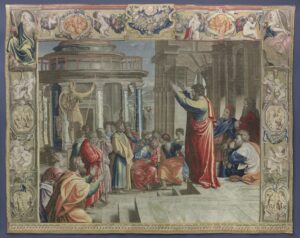Six tapestries from Germany have never appeared in the U.S. before their premiere this summer
COLUMBUS, Ohio – As part of a historic exhibition, the Columbus Museum of Art (CMA) will bring a set of six important tapestries designed by Raphael from the Gemäldegalerie Alte Meister (GAM) in Dresden, Germany, to the U.S. for the first time. These tapestries are woven from the same Raphael designs used to create the tapestries for the Sistine Chapel in the Vatican in 1515-16. Raphael—The Power of Renaissance Imagery: The Dresden Tapestries and their Impact will be on view at the Columbus Museum of Art in Columbus, Ohio, the exclusive U.S. venue, from July 17 to Oct. 30, 2022. The exhibition, which will be accompanied by a scholarly catalogue published in German and English, demonstrates the enduring influence of Raphael’s designs and the tapestries across eras and realms.
Raphael—The Power of Renaissance Imagery: The Dresden Tapestries and their Impact is organized by the Gemäldegalerie Alte Meister, Staatliche Kunstsammlungen Dresden (Old Masters Gallery, Dresden State Art Collections) in partnership with CMA. The project originated as part of the international celebration of the 500th anniversary of Raphael’s death.
“The Columbus Museum of Art looks forward to hosting this momentous exhibition that lends keen insight into Raphael’s epic visual achievements and how these have informed creative artists ever since they were unveiled in the 16th century,” said Nannette Maciejunes, CMA executive director and CEO.
The Dresden works were woven in England in the 17th century at the noted Mortlake Tapestry manufactory. The production of the tapestries in England is a direct consequence of the acquisition of Raphael’s original cartoons (full-scale Renaissance preparatory drawings for a tapestry) by the Prince of Wales (later Charles I) for the British royal collection in 1623. Charles I subsequently commissioned sets to be woven in the Mortlake manufactory, England’s recently founded tapestry factory located just outside London. The tapestries were brought to Germany in the 18th century by Augustus the Strong (Elector of Saxony and King of Poland). The tapestries were restored in 1991-2003 by Gemäldegalerie Alte Meister and debuted at the opening of the exhibition at GAM in 2020. The Columbus presentation, which was delayed by the pandemic, marks the first time they have ever traveled to the United States.
Commissioned by Pope Leo X, in part to reinforce the authority of the papacy, the tapestries and cartoons from which they are created depict episodes in the lives of Saints Peter and Paul. Raphael’s works consist of monumental figures set against backdrops of landscape or architecture. Considered by many to rank among the greatest paintings ever produced, these masterworks and the tapestries woven from them are renowned for their figures’ magisterial poses, elegant ensemble groupings, harmonious and dynamic compositions, and dramatic narratives presented with remarkable clarity and economy of means. Their importance to European tapestry design was also profound. The tapestries represent a major stylistic shift, from an aesthetic based on flattened space and decorative pattern – medieval in derivation – to the simulation of illusionistic, three-dimensional space populated by towering figures, bringing tapestry design in closer formal alignment with painting. Raphael’s cartoons are represented in the exhibition with two full-scale facsimiles, created specifically for Dresden and Columbus.
In addition to the tapestries, exhibition highlights will include two drawings by Raphael that were studies for his cartoons; works by Renaissance and Baroque masters influenced by the tapestries, such as Albrecht Dürer, Nicolas Poussin and Peter Paul Rubens; 19th-century works that illustrate the tapestries’ continued impact; and portraits of the powerful individuals involved in producing and acquiring the Dresden tapestries, notably Charles I of England and Augustus the Strong.
The exhibition marks the third collaboration between CMA and the Gemäldegalerie Alte Meister. In 1999 CMA presented the exhibition Ages of Splendor and Enlightenment: Eighteenth-Century Paintings from the Old Masters Picture Gallery, consisting of works from the GAM’s permanent collection. In 2018 the GAM lent the Columbus Museum of Art a Venetian masterpiece, which served as the centerpiece of the exhibition Titian’s Lady in White: A Renaissance Mystery. This monographic installation was dedicated to the iconography, restoration, provenance and cultural context of one of Titian’s greatest portraits.
The exhibition is supported by the Samuel H. Kress Foundation.

